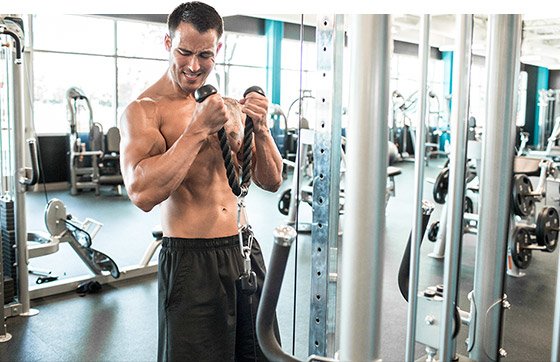Part 1 | Part 2
Due to the response to my biceps article, I decided to do another one, dealing with some of the many questions I've been asked. One of the main questions has to do with workout frequency. It's important to talk about one as I see that a lot of people are training way too often, in some cases doing biceps every day, only taking one rest day a week, and so on.
The critical fact that is missed by a lot of people is that you grow in between workouts, not because of how many workouts you do. Guys train too often for a lot of reasons, from simple enthusiasm to just not knowing any better.
Gains will come faster if you take adequate rest days. But workout frequency is dependent on a lot of factors: age, experience, how intense you train, whether or not you're natural and how much time you have to train, to name a few. I find, being older and natural, training each body-part once per "workout week" works well for me.
Recovery Time

"If you're still sore from your last workout, you still haven't recovered."
This means I only workout once every 3-4 days on a 3 way split; and by "work-out week", I mean the length of time it takes me to complete that split, which is usually around 9-12 days. Not much time in the gym, I know, but I grow that way. For you young guys out there, working out 3 times within 7 days will allow good recovery.
A good rule of thumb is, if you're still sore from your last workout, you still haven't recovered and you should wait at least one more day. A lot of guys "rest" one group of body parts while training another group, not realizing that any training puts a drain on your whole system, compromising recovery and, ultimately, growth.
Now, let me say, a lot of this doesn't really apply if you are not natural. Let's face it, drugs do a lot to cover recovery and quite honestly, compensate for a lot of training mistakes.
In my first article, I talked about adding intensity techniques to your workout, one of the other questions I've been asked is, how to exactly apply those techniques to the routines.
With the routine I'm about to suggest, I want to give you exact techniques to use.
Pre Vs. Post Exhaust
This routine will be based around post exhaust super sets. You can apply the idea of post exhaust supersets for the same muscle group to other muscles, such as chest and back.
Post exhaust means you do a compound exercise first, and then go right into an isolation exercise. Why post exhaust as opposed to pre exhaust? Because with pre exhaust, you first do an isolation exercise to target the primary muscle, then you go right into your compound movement.
The idea is that since the weaker secondary muscles give out first, you will better hit the primary muscle this way. (example—in the bench press, the chest is the primary muscle, but the triceps and front delts are heavily involved.
Since they are smaller and weaker, they will give out before the chest is completely stimulated, so by doing a pre exhaust super set, you work around this problem).
My problem with pre exhaust is that by doing the compound second, you have to use less weight than you would if you did it first. More weight equals more strength equals more muscle.
Why not start with a heavy compound movement for 6-8 reps, then go right into an isolation exercise, thereby taking the weaker supporting muscles out of it, and continuing to target the primary muscle?
This way, if any exercise suffers due to having to use less weight, it's the less important isolation exercise, not the critical compound exercise. It really does make sense if you think about it. Of course, you should try them both to see which one you like the best.
On To The Routine
Exercises: EZ-Bar Curl + Hammer Curl
2 sets of 6-8 reps

EZ-Bar Curl
Go right into the hammer cable curls to failure, then extend the set by doing partials. The hammer curls brings me to another question—are these done like the picture (straight up and down) or like my description (curl to the opposite shoulder)? Actually, both methods are correct, try them both and see which one you like.
Do no more than two of these supersets. That's it, that's the workout.

Cable Hammer Curls - Rope Attachment
If done right, you may not make it through the second superset. If you do complete both and feel like you haven't worked hard and want to do more, you didn't train hard enough.
The keys to this workout are insuring you go to failure, and extending the set as much as you can. There are some other techniques you can use as well. If you don't have a training partner to help with the forced reps, you can set up your bar with smaller plates on either side, no collars, and do drop sets instead.
The premise behind forced reps and drop sets, and rest pause for that matter are pretty similar. So you do your set to complete failure, then simply put the bar down, strip off a plate from either side and continue. Do this 3 times. Also be sure you strip the plates off as fast as possible, don't use it as an excuse to rest.
If you've been using my routine as listed but haven't used any intensity techniques, after 4-6 weeks on the first routine, switch to the one listed above, and take note of alternating cable curls, as suggested below, with the hammer curls.
Hammer Curl Question
"The key is not to stagnate on any one program for to long."
Going back to the question about hammer curls, the other exercise description that people wonder about is the cable curls across a flat bench. These are really a lot like a concentration curl. Sit on the floor, put your arms across a flat bench so your elbows just hang off, you should have a nice stretch in the biceps, then perform a regular curl. Hold at the top for a 2 count. Don't try to use too much weight on this.
You should really feel this in the belly of the muscle. This exercise could be used in the above super set in place of hammer curls, or alternated with that exercise: for example, one workout do hammers, the next use the cable curls.
Low Set Numbers
Other questions had to do with the low set number—one thing being missed here is that I suggest 2 working sets per exercise, not 2 total sets. However, I understand a lot of people like to do a lot of sets. That's fine but if you're doing 10, or 12 or 15 sets for biceps, how hard can you possibly be working? Believe what you believe but don't be afraid to try new things.
My approach is somewhat "high intensity" in that I think training very intensely will produce better results than just doing set after endless set. But let's go one step further, what the body really thrives on is change and you can get results from most routines for a little while. The key is not to stagnate on any one program for to long.
Conclusion
Well, these were the main topics I wanted to cover, I think there is way too much misunderstanding about some of the more basic principles of bodybuilding, that's why I try to write for the newer guys.
God knows, I wish I had access to this kind of information—and a website (there was no such thing when I started) like Bodybuilding.com.

